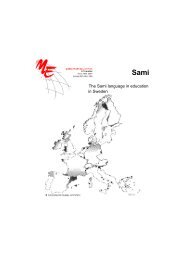Multilingual Early Language Transmission (MELT) - Mercator ...
Multilingual Early Language Transmission (MELT) - Mercator ...
Multilingual Early Language Transmission (MELT) - Mercator ...
Create successful ePaper yourself
Turn your PDF publications into a flip-book with our unique Google optimized e-Paper software.
8. “Immersion Preschooling in Ireland: Training Provision and Best<br />
Practice”<br />
Dr. Tina Hickey<br />
Professor at the University College Dublin<br />
Introduction<br />
Preschooling through the medium of lesser-used languages has played an important role in<br />
the revitalisation movements of many minority and heritage languages. It has been found<br />
that it is easier for parents and language activists to establish a preschool offering an<br />
appropriate curriculum through a non-dominant language, than to attempt to establish a<br />
primary school. Surveys of pre-primary provision in lesser-used languages in Europe (e.g. van<br />
der Goot et al., 1994) have highlighted the importance of providing monolingual preschool<br />
immersion in endangered languages both to native speakers, who may be in need of mother<br />
tongue development and enrichment (Corson, 1993; Baker and Jones, 1998), and to<br />
dominant language children learning the target language as L2. Such preschools help to raise<br />
the status of the minority language in children's eyes, as well as in the local community, and<br />
promote awareness of the need to maintain the language. Preschool education through the<br />
minority language benefits mother-tongue speakers, helping them to develop firm<br />
foundations in their first language before acquiring the dominant language later. One<br />
example of such preschools is seen in the Irish-medium preschools known as naíonraí, which<br />
offer early immersion in Irish as L2 for the majority of children coming from English-speaking<br />
homes, but also provide mother-tongue pre-primary education for the minority who are<br />
native speakers of Irish (Hickey, 2001). These naíonraí function for between two and three<br />
and a half hours per day for groups of children aged 3-4 years. There are 185 such groups,<br />
serving approximately 3,800 children in English-speaking communities in Ireland (according<br />
to the umbrella body Forbairt Naíonraí Teo.). In Irish-speaking communities, a further 74<br />
groups operate (under the aegis of Comhar Naíonraí na Gaeltachta Teo.) serving another<br />
1000 children.<br />
The Irish Context<br />
While Irish is described in the Constitution as the ‘first official language’ of the Republic of<br />
Ireland, it is English (also a constitutionally recognised official language) that is spoken by the<br />
majority most of the time. Efforts at revitalising Irish have had mixed success (Ó Laoire,<br />
2006): there has been growth in the numbers of second language speakers of fairly low<br />
proficiency, but a decline in the number of native speakers, and a decrease in the use of the<br />
language overall. Census 2006 (CSO, 2007) found that 1.66 million people aged three years<br />
and over were ‘able to speak Irish,' representing 42% of the population. However, 60% of<br />
these reported that they either never actually speak Irish, or do so less often than once a<br />
week. Learners’ main use of Irish is in school and only about 4% (68,685) of those who can<br />
speak the language speak it daily outside of education. Thus, for Irish, the educational<br />
context has become a highly significant arena for maintaining and speaking the language, as<br />
well as a place where it is learned.<br />
101



